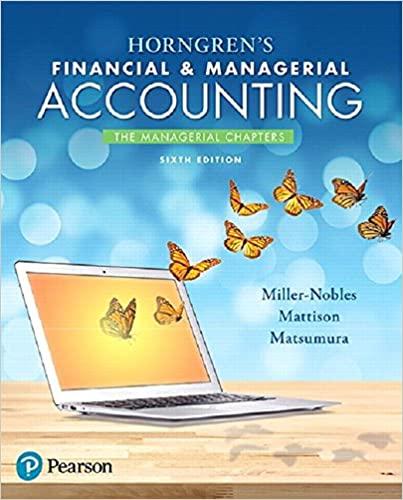Question
Billy Company developed the following budgeted life-cycle income statement for two proposed products. Each product's life cycle is expected to be two years. Product A
Billy Company developed the following budgeted life-cycle income statement for two proposed products. Each product's life cycle is expected to be two years.
Product A Product B Total
Sales $ 200,000 $ 200,000 $ 400,000
Cost of goods sold $120,000 $130,000 $250,000
Gross profit $ 80,000 $ 70,000 $ 150,000
Period expenses:
Research and development ($70,000)
Marketing ($50,000)
Life-cycle income $ 30,000
A 10 percent return on sales is required for new products. Because the proposed products did not have a 10, percent return on sales, the products were going to be dropped.
Relative to Product B, Product A requires more research and development costs but fewer resources to market the product. Sixty percent of the research and development costs are traceable to Product A, and 30 percent of the marketing costs are traceable to Product A.
1. If research and development costs and marketing costs are traced to each product, life-cycle
income for Product A would be
a. 38,000.
b. 27,000.
c. 23,000.
d. 15,000.
2. If research and development costs and marketing costs are traced to each product, life-cycle
Income for Product B would be
a. 35,000.
b. 20,000.
c. 12,000.
d. 7,000.
3. Return on sales for Product A would be
a) 40%
b) 25%
c) 11.5%
d) 2.5%.
4. When is the best time during the product life cycle to implement cost reduction measures?
A. during the production stage of the product life cycle
B. during the planning stage of the product life cycle
C. during the logistics stage of the product life cycle
D. at any time during the product life cycle
5)Life-cycle cost management does NOT consist of
1. Actions taken to enable a product to be designed, developed, produced, marketed, distributed, operated, maintained, serviced, and disposed of in order to maximize profits.
2. Actions to extend the life of a product through design, development, production, and maintenance.
3. Actions that focus on minimizing the cost of developing, designing, producing, distributing, operating, servicing, and disposal of a product.
4. Actions taken to design, develop, test, market, distribute, maintain, service, and dispose of a product to maximize revenues.
A: 1, 2, 3
B: 2, 3, 4
C: 3, 4,1
D: 4, 1,2,
| 6) Management at Kirkland Machine Tool Co. is considering the development of a new automated | ||||||||
| drill press called the Auto Drill. After conferring with the design engineers., the controller's staff | ||||||||
| assembled the following data about this project. | ||||||||
| Target selling price | $ 7,500.00 | |||||||
| Desired profit percentage | 25% of total unit cost | |||||||
| Projected unit demand | 4500 units | |||||||
| Activity-based cost rates | ||||||||
| Materials handling activity | 5% of raw materials and purchased parts cost | |||||||
| Engineering activity | $300 per unit for Auto Drill | |||||||
| Production and assembly activity | $50 per machine hour | |||||||
| Delivery activity | $570 per unit for Auto Drill | |||||||
| Marketing activity | $400 per unit for Auto Drill | |||||||
| Per unit data | ||||||||
| Raw Materials cost | $ 1,620.00 | |||||||
| Purchased parts cost | $ 840.00 | |||||||
| Manufacturing labor hours | 6 hours | |||||||
| Hourly rate | $ 14.00 | |||||||
| Assembly labor hours | 10 hours | |||||||
| Hourly labor rate | $ 15.00 | |||||||
| Machine hours | 30 hours | |||||||
| A) Compute the product's Target cost. | (2 marks) | |||||||
| B) Compute the product's projected unit cost based on the design engineers estimates. (2 marks) | ||||||||
| C) should management produce and market the Auto Drill? Defend your answer. (1 mark) | ||||||||
Step by Step Solution
There are 3 Steps involved in it
Step: 1

Get Instant Access to Expert-Tailored Solutions
See step-by-step solutions with expert insights and AI powered tools for academic success
Step: 2

Step: 3

Ace Your Homework with AI
Get the answers you need in no time with our AI-driven, step-by-step assistance
Get Started


